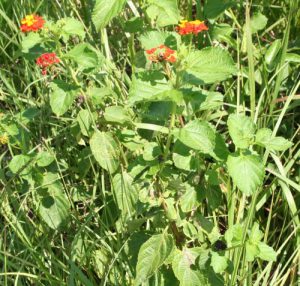
Lantana is a landscape plant that easily escapes cultivation and spreads. Photo Credit: Jennifer Bearden
You know that plant in the corner of the yard that seems to be taking over? It’s the one that your friend “passed along” because they had plenty of them and wanted to share. After all, it grows so well. How can you go wrong?
The odds are that vigorous plant is a non-native species. The majority of what is sold in nurseries are introduced from a foreign country and developed for their uniqueness. The problem is that many of the plants brought into the United States arrive without their natural enemies. Under the long, warm growing season found in Florida, these non-native plants become the dominant plant in an area and manage to out-compete the native plants. When this happens, these introduced plants get labeled as an “invasive species”.
These invasive species threaten Florida’s environment, economy and health, requiring an estimated $120 billion a year to control them. Learning which of these plants have the potential to become invasive has been a focus of researchers with the UF/IFAS Center for Aquatic and Invasive Plants. They have spent more than a year developing a searchable website and database to help Floridians assess problem non-native plants. The website features more than 800 species, is easily searchable by common or scientific name, and the results can be filtered. The site helps predict the invasive potential. Each species is categorized as “caution”, “invasive not recommended”, or “prohibited” based on their ecological threat.
If you want to learn more about your friend’s ”passalong” plant be sure to visit the Assessment of Nonnative Plants in Florida’s Natural Areas website and database. Also check the FLEPPC (Florida Exotic Pest Plant Council) list. Also make sure new plants are not on the Florida Noxious Weed List or the Federal Noxious Weed List.
- Sunshine in the Winter - December 20, 2024
- Helene’s Potential Impact on the Florida Coastal Wetlands - October 4, 2024
- April is Safe Digging Awareness Month - April 6, 2024
